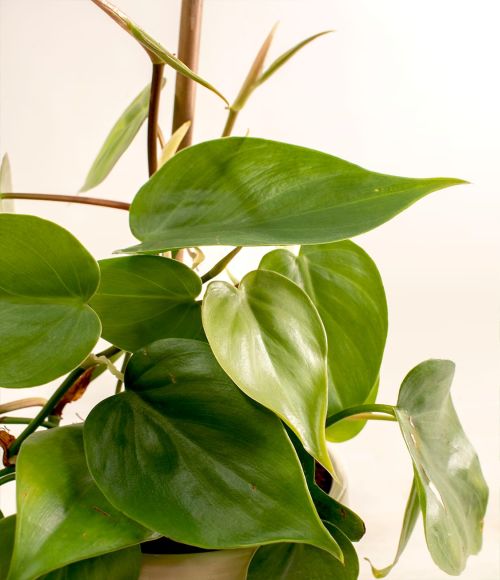Heartleaf Philodendron (Philodendron hederaceum)
Last
updated: August 3,
2025
Care Sheet List
The
Heartleaf Philodendron is a beloved houseplant, famous for its
cascading vines
adorned with glossy, heart-shaped leaves. It's incredibly forgiving and
adaptable, making it an excellent choice for beginners and experienced
plant
parents alike.
Lighting
Heartleaf
Philodendrons are very tolerant of various light conditions, which
contributes
to their popularity.
- Ideal: Medium
to low indirect light is perfect. They thrive in locations
that receive dappled light or are a few feet away from a bright window
(east or north-facing is often ideal).
- Tolerates: They can
survive in surprisingly low light environments,
though their growth may become leggy, and new leaves might be smaller.
- Avoid: Direct,
harsh sunlight will scorch their leaves, causing them to turn
yellow and develop brown crispy spots.
Watering
Routine
This plant
prefers its soil to dry out somewhat between waterings.
It's more
tolerant of slight underwatering than overwatering, which can lead to
root rot.
- Frequency: Water when the top
2-3 inches of soil feel dry to the touch. You can use your
finger to check the moisture level. The leaves may also start to look
slightly limp or dull when the plant is thirsty.
- Method: Water
thoroughly until you see water draining from the bottom of the pot.
Ensure no excess water is left standing in the saucer, as this can lead
to root rot.
- Seasonality: Reduce watering
frequency in the fall and winter months, as the plant's growth
naturally slows down.
Fertilizer
Requirements
Heartleaf
Philodendrons are not heavy feeders.
- Schedule: Fertilize
during their active growing season, which is typically from spring
through early fall. Once every 2-4 weeks is generally
sufficient.
- Type: Use a balanced
liquid houseplant fertilizer.
- Commercial Recommendation: Miracle-Gro
Indoor Plant Food (Liquid) or Schultz Liquid Plant
Food are easily accessible and effective options. Dilute these commercial concentrates to achieve approximately 50-100 ppm N
in your final solution. This is often equivalent to using them at "half
strength" or "full strength" of the package's recommended dose.
- DIY Fertilizer Suggestion: For robust foliage growth, use your homemade 3-1-2 liquid fertilizer concentrate (High Nitrogen) or a balanced 1-1-1 liquid fertilizer concentrate.
- For 3-1-2 concentrate (30,000 ppm N): Apply at a "Light to Moderate Feeding" rate, using 1.67 ml to 3.33 ml per 1 liter of water (resulting in ~50-100 ppm N). See recipe details.
- For 1-1-1 concentrate (10,000 ppm N): Apply at a "Moderate Feeding" rate, using 10 ml per 1 liter of water (resulting in ~100 ppm N). See recipe details.
- Avoid: Do not
fertilize in late fall and winter when the plant is in a period of
reduced growth or dormancy.
Misting
Requirements
Heartleaf
Philodendrons tolerate average household humidity levels very well and do
not strictly require regular misting. However, like most
tropical plants,
they do appreciate slightly higher humidity.
- Optional Benefit: If your home's
air is particularly dry (e.g., due to heating in winter), occasional
misting a few times a week or placing the pot on a pebble tray filled
with water (making sure the pot is not sitting directly in the water)
can be beneficial for leaf health and vigor.
Pot Size
and Soil Type
- Pot Size: When repotting,
choose a pot that is 1-2 inches larger in diameter
than its current one. Heartleaf Philodendrons don't mind being slightly
root-bound, and this can actually encourage fuller top growth.
Repotting is typically needed every 1-2 years or when you see roots
circling the inside of the pot or emerging from the drainage holes.
Ensure the pot has drainage holes to prevent water
from accumulating.
- Soil Type: Use a well-draining,
all-purpose potting mix. A standard indoor potting mix is
generally suitable. To further enhance drainage and aeration, you can
amend the potting mix with about 1 part perlite to 4-5 parts
potting mix. This will ensure good air circulation around the
roots and prevent waterlogging.
Pruning
and Maintenance
- Pruning: To encourage a
bushier plant and prevent it from becoming too leggy, you can prune
back long, trailing vines. Cut the stem just above a leaf node (the
point where a leaf emerges from the stem).
- Propagation: Heartleaf
Philodendrons are incredibly easy to propagate! Simply take a stem
cutting with a few leaves and at least one node, and place it in water
or moist potting mix. Roots will typically form within a few weeks.
- Toxicity: Like many
common houseplants, Heartleaf Philodendron is considered toxic if
ingested due to calcium oxalate crystals. Keep out of reach of pets and
small children.


